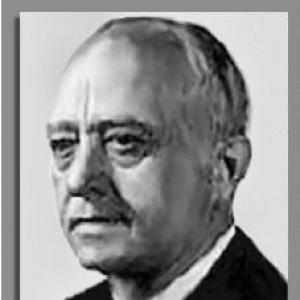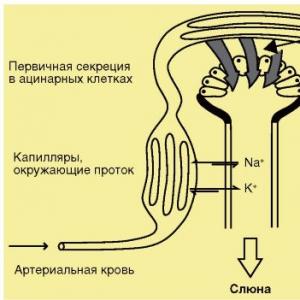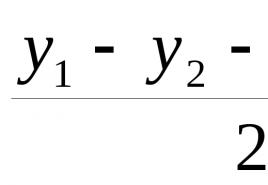What does a complex non-union sentence mean? Unionless proposals
47. Unionless complex sentences. Semantic relations between parts of a non-union sl. Suggestions and means of expression.
A unionless complex sentence is a complex sentence in which simple sentences are combined into one whole in meaning and intonation, without the help of conjunctions or union words: [A habit from above is given to us]: [it is a substitute for happiness] (A. Pushkin).
The semantic relations between simple sentences in union and non-union complex sentences are expressed in different ways. In union sentences, unions take part in their expression, therefore, semantic relations are more definite and clear here. For example, the union so expresses the effect, because it is the cause, if it is the condition, however, the opposition, etc.
In a non-union complex sentence, the semantic relations between simple sentences are expressed less clearly than in a union one. In terms of semantic relations, and often in intonation, some non-union complex sentences are closer to complex sentences, others to complex ones. However, often the same non-union complex sentence in meaning can be brought closer to both a compound sentence and a complex sentence. Wed, for example: Searchlights came on - it became light around; Searchlights came on, and it became light around; When the spotlights came on, it became light around.
Semantic relations in non-union complex sentences depend on the content of those included in them simple sentences and expressed in oral speech intonation, and in writing with various punctuation marks (see the section "Punctuation marks in a non-union complex sentence").
In non-union complex sentences, the following types of semantic relations between simple sentences (parts) are possible:
I. Enumeration (lists some facts, events, phenomena):
[I_ haven't seen you for a whole week], [I haven't heard you for a long time] (A. Chekhov) -,.
Such non-union complex sentences converge with complex sentences with a connecting union and.
As well as synonymous complex sentences, non-union complex sentences can express the meaning of 1) the simultaneity of the listed events and 2) their sequence.
1) , [horses were neighing in the darkness], [a tender and passionate song-dumka floated from the camp].
Unionless complex sentences with enumeration relations can consist of two sentences, or they can include three or more simple sentences.
II. Causal (the second sentence reveals the reason for what the first says):
[I am unhappy]: [guests every day] (A. Chekhov). Such non-union complex sentences are synonymous with complex sentences with reason clauses.
III. Explanatory (the second sentence clarifies the first):
1) [Objects lost their shape]: [everything merged first into gray, then into a dark mass] (I. Goncharov) -
2) [Like everyone in Moscow, your father is like that]: [he would like a son-in-law with stars and ranks] (A. Griboyedov) -
Such non-union sentences are synonymous with sentences with an explanatory union viz.
IV. Explanatory and explanatory (the second sentence explains a word in the first part that has the meaning of speech, thought, feeling or perception, or a word that indicates these processes: listened, looked, looked around, etc.; in the second case, we can talk about skipping words like see , hear, etc.):
1) [Nastya remembered during the story]: [she had a whole untouched pot of boiled potatoes from yesterday] (M. Prishvin) -:.
2) [She came to her senses, Tatiana is looking]: [no bear] ... (A. Pushkin) -:.
Such non-union sentences are synonymous with complex sentences with explanatory clauses (I remembered that ...; looks (and sees that) ...).
V. Comparative-adversarial relations (the content of the second sentence is compared with or opposed to the content of the first):
1) [All happy families are similar to each other], [each unhappy family is unhappy in its own way] (L. Tolstoy) -,.
2) [Chin followed him] - [he suddenly left the service] (A. Griboyedov) - -.
Such non-union complex sentences are synonymous with compound sentences with adversary conjunctions a, but.
Vi. Conditionally temporary (the first sentence indicates the time or condition for the implementation of what is said in the second):
1) [Do you like to ride] - [love to carry sleds] (proverb) - -.
2) [You will see Gorky] - [talk to him] (A. Chekhov) -.
Such sentences are synonymous with complex sentences with clauses or tenses.
Vii. Consequences (the second sentence names a consequence of what the first says):
[A light rain sows in the morning] - [impossible to get out] (I. Turgenev) - ^ TT
Unionless complex sentence (BSP) is a complex sentence, parts of which are connected intonationally without the help of conjunctions and union words. BSPs are often found in fairy tales, in fiction and colloquial speech, among proverbs and sayings.
Unionless complex sentences differ from allied ones in that the syntactic connection of the parts complex sentence expressed in them without the help of conjunctions and allied words. The syntactic connection is expressed in them intonationally. Intonation also helps define the meanings of sentences, which out of context can often be defined in different ways.
In non-union complex sentences, the means of connecting the sentences-parts of the BSP are:
- intonation;
- the order of arrangement of proposals in the composition of the BSP;
- the ratio of the type and tense of verbs in sentences.
This BSP differs from complex and complex sentences, in which this role is played by unions.
Unionless sentences can consist of two or more simple or complex sentences, between which, depending on the meaning, a comma, colon, dash or semicolon is placed.
The teacher fell ill, the lesson was postponed.
(sequencing)
The teacher fell ill: classes were postponed.
(explanation)
The teacher fell ill - classes were postponed.
(causal relationship)
Unionless complex sentences are usually designated BSP.
Classification of non-union sentences
The most common classification of non-union complex sentences is the classification by meaning.
1. BSP with sequence value:
A strong and harsh wind blew, the sky was overcast.
2. BSP with the meaning of explanation:
Something incomprehensible is happening to me: I am anxious for no reason.
- In such sentences, the union can be mentally substituted namely... The second sentence clarifies the first
3. BSP with complement value:
I went into the house: it was clean and cool.
- The second sentence complements the first by providing additional information.
4. BSP with the meaning of the reason:
I took offense at him: he was guilty in front of me.
The second sentence gives the reason for the first. From the first sentence, one can ask why?
5. BSP with condition value:
If I want, everything will be my way.
The first clause contains a condition, a union can be substituted if a.
6. BSP with the significance of the investigation:
Freezing rain has passed - so many trees have been broken.
The second sentence contains a consequence of the events referred to in the first part. Unions can be added to the second sentence wherefore or so that.
7. BSP with time value:
The rain stopped - the children ran into the street.
The union can be substituted in the first sentence when.
8. BSP with match value:
Business time - fun hour.
The union can be substituted in the second sentence and.
Examples of BSP schemes:
[…], […] Is a non-union complex sentence, for example:
By evening it got warmer / frogs were croaking in the garden.
[…] - […] is a non-union complex sentence, for example:
I went up to the third floor and went to the door - / suddenly a desperate dog barking was heard from behind it.
[…]: […] Is a non-union complex sentence, for example:
Hearing the noise, I lowered my eyes: / a hedgehog ran right in front of me.
A generalizing word for homogeneous members of a sentence. A generalizing word is a word that is general in relation to homogeneous members of a sentence. Homogeneous members of the sentence clarify, concretize the generalizing word. A generalizing word can be attributive pronouns and adverbs (everything, always, everywhere, everywhere), as well as other members of the sentence and whole phrases. Generalizing words are the same member of the sentence as homogeneous members. Depending on the position, there are three types of structures (with examples): ... generalizing words (OS): Ο, Ο, Ο. Arbuzov liked everything about him: his cheerful character, generosity, refined delicacy. Ο, Ο, Ο - wasps ... Cheerful character, generosity, refined delicacy - everything about him pleased Arbuzov. os: Ο, Ο, Ο -… Everything: cheerful character, generosity, refined delicacy - Arbuzov liked him.
Unionless complex sentence. Parts of a non-union complex sentence are connected only with the help of intonation. UNION between grammatical basics NOT. A semicolon, colon, dash can be used between parts of a non-union sentence.
The most common classification of non-union complex sentences is the classification by meaning.
BSP with sequence value:
A strong and harsh wind blew, the sky was overcast.
BSP with the meaning of the explanation:
Something incomprehensible is happening to me: I am anxious for no reason.
In such sentences, the union can be mentally substituted viz. The second sentence clarifies the first.
BSP with complement value:
I went into the house: it was clean and cool.
The second sentence complements the first by providing additional information.
BSP with reason value:
I took offense at him: he was guilty in front of me.
The second sentence gives the reason for the first. From the first sentence, one can ask why?
BSP with condition value:
If I want, everything will be my way.
The first clause contains the condition that the union can be substituted if.
BSP with the meaning of the investigation:
Freezing rain has passed - so many trees have been broken.
The second sentence contains a consequence of the events referred to in the first part. Unions can be added to the second sentence because of what or so.
BSP with time value:
The rain stopped - the children ran into the street.
In the first sentence, the union can be substituted when.
BSP with matching value:
Business time - fun hour.
The union a can be substituted in the second sentence.
Examples of BSP schemes:
[…], […] Is a non-union complex sentence, for example:
By evening it got warmer / frogs were croaking in the garden.
[…] - […] is a non-union complex sentence, for example:
I went up to the third floor and went to the door - / suddenly a desperate dog barking was heard from behind it.
[…]: […] Is a non-union complex sentence, for example:
Hearing the noise, I lowered my eyes: / a hedgehog ran right in front of me.
The task.
Closer to sunset, the frost stealthily returned: at night it was still the lord.
1) The generalizing word stands before homogeneous members offers.
2) The second part of the sentence indicates the reason for what is said in the first. 3) The first part of the non-union sentence indicates the condition of what is said in the second part.
We find the grammatical basis: the frost was returning and he was the lord. The colon is between parts of a complex sentence. Answer option number 1. This option is omitted, since it characterizes the relationship between the generalizing word and homogeneous members of the sentence. Answer option number 2. The meaning of the reason is transmitted through the union why. We rework the proposal: Towards sunset, the frost stealthily returned, because at night he was still the lord. Union really fits. Answer options 3 and 4. They characterize a non-union sentence in which a dash is used between grammatical stems. Thus, the correct answer is # 2.
How to explain the use of the colon in this sentence?
Marina Tsvetaeva's legacy is great: the poetess has written seventeen poems, eight poetic dramas, memoirs, historical-literary and philosophical-critical prose.
1) The first part of a non-union complex sentence indicates the condition of what is said in the second part.
2) The second part of the non-union complex sentence explains, reveals the content of the first part.
How to explain the use of the colon in this sentence? A special stage in the fate of Kazemir Malevich was 1905: on the 5th of August of this year, he applied for admission to the Moscow School of Painting, Sculpture and Architecture.
1) The second part of the non-union complex sentence indicates the reason for what is said in the first part.
3) The second part of the non-union complex sentence contains an indication of the rapid change of events.
4) The first part of a non-union complex sentence indicates the condition of what is said in the second part.
How to explain the use of the colon in this sentence?
In the 20th and 21st centuries, Korean cities built in mountainous areas no longer followed the Chinese scheme: their streets were not straight, and the ensembles of palaces and temples, watch towers and fortress structures fit into the surrounding landscape, making up a single whole with it.
1) The second part of the non-union complex sentence explains, reveals the content of the first part.
3) The generalizing word stands before the homogeneous members of the sentence.
4) The first part of the non-union complex sentence indicates the time of the accomplishment of what is said in the second part.
In a non-union complex sentence, one of the main means of communication is missing - unions and union words... The function of linking and expressing relations between parts is performed mainly by intonation. In some constructions, additional means are used: 1) demonstrative pronouns (so, such, one, etc.); 2) words with general indicative meaning (first, first, therefore, this, therefore, for this, etc.); 3) the ratio of the temporal forms of the verb, mood forms.
The lack of allied means makes it difficult to express certain types of relations, for example, concessions: Chin followed him - he suddenly left the service (Tr.); comparative: The word says - the nightingale sings and some others. However, the flexible structure of intonation allows one to overcome these difficulties.
In non-union complex sentences, the role of punctuation marks is more important than in union sentences; the rules for their use are more complex. Thanks to signs, sentences of the same structure are distinguished, but with different types of relations; Wed, for example: The car has stopped, the engine has stalled (enumeration); The car stopped: the engine stalled (the reason is in the second part); The car stopped - the engine stalled (consequence in the second part); these sentences have different intonation structures.
Unionless complex sentences have, like union, equivalent or unequal parts. In this way, they are similar to complex or complex. However, in non-allied units, neither independence nor dependence of the units is formally expressed.
Equivalent clauses can express two kinds of relationship: enumeration and matching.
Enumeration is expressed by intonation ("enumeration intonation"), which is characterized by a uniform increase in tone at the end of each part; the number of parts is not limited; for example: It was beginning to get light, the river was foggy, our fire went out (Cor.). The enumeration expresses simultaneity ( verb forms imperfect form) or time difference (perfect form); for example: Thick dew lay on crumpled grass, heavy drops fell from lime leaves (A.T.); The sloping bank of the Dnieper became dark; from the east a shadow pours into the night (P.).
When listing, commas are placed between the parts of a non-union complex sentence.
The juxtaposition is expressed by intonation ("adversarial"), a feature of which is a higher tone in the first predicative part, a lower one in the second, with a pause between the parts. The juxtaposition usually relies on the use of antonyms; for example: Darkness does not love light - evil does not tolerate good (Posled.); You are rich - I am very poor; you are a prose writer - I am a poet (P.). The number of parts is limited to two. The punctuation mark is a dash.
Sentences of an equivalent type can be rearranged into compound sentences, that is, they allow the introduction of constructive conjunctions and, a.
In sentences of unequal type, the logical connection of events, provisions is expressed.
Conditional relationships reflect the conditioning of one event by another; the condition is in the first part. The main character is a dash; for example: They go ahead - they do not regret hair (Last); the meaning of the condition can be based on the form of the subjunctive mood; for example: There would be a field, we will find a bipod (Pos.).
Causal relationships: 1) cause in the second predicative part; for example: The joys of life cannot be kept forever: joy comes and goes, like a guest (Prishv.); 2) the investigation in the second part; for example: Learn the good - the bad will not come to mind (Last).
In sentences with the meaning of the cause, the main sign is the colon, with the meaning of the effect - the dash.
Explanatory relations are expressed in the second part of a non-union complex sentence in the following cases: 1) in the first part there is an index word; for example: This voice has always meant only one thing: other people need your immediate, urgent help (Sol.); 2) in the first part, a verb is used that needs completion; for example: So, you were not mistaken: three treasures in this life were a joy to me (P.); 3) in the first part, a word with a metaphorical or too broad meaning is used, which needs clarification, clarification; for example: Weather and gratitude - relatives: one was born in nature, the other - in the human soul (Prishv.).
In sentences with explanatory relationships, the colon is the main character.
Sentences of an unequal type can be rearranged into complex ones using the appropriate conjunctions (if, because, so, etc.).
In addition to proposals of an equivalent and unequal type, connecting structures have a non-union structure. They are not analogous to complex and complex subordinate, do not allow the introduction of the corresponding unions.
Firstly, these are sentences where in the first part verbs are used that call actions related to perception: looked out, looked around (to see), froze, hid (to hear), etc., or which designate perception that is not directed directly at the object: listened, looked, peered and under. The second part of a non-union complex sentence denotes an event, a position that is perceived; for example: Samghin looked around: behind him was a young girl sitting on the sofa and crying sobbingly (MG); Suddenly everyone fell silent and raised their heads: from behind the hut appeared a neighbor (B.).
Colons are used in these sentences.
Secondly, the first part is complete, does not need to be added; the second part expresses the content, which is also quite independent. The main character is a semicolon; for example: But here on the bell tower of the monastery five o'clock struck; the evening was rapidly approaching (T.).
Modern Russian literary language / Ed. P.A.Lekanta - M., 2009
Depending on the meanings of the parts of non-union complex sentences and the type of intonation as the most important formal aspect of their construction, various types of non-union complex sentences are distinguished:
- Unionless complex sentences with the meaning of enumeration: Morning was still dozing in one of the alleys in Sololaki, a shadow lay on the gray wooden low houses (K. Paustovsky); The horses started, the bell rang, the wagon flew ... (A. Pushkin); It was already September, the last harvests were ripening in the garden and taiga (V. Rasputin). These sentences refer to events that occur simultaneously or sequentially and describe the overall picture. These sentences are characterized by enumerative intonation. Such sentences are often used when describing something (nature, man, interior): The roof had long been painted, the glass gave off a rainbow, grass grew from the cracks between the steps (A. Chekhov); Hazel branches bent over the tree to form a green canopy; the sky shone through the branches in the colors of the sunset; the spicy smell of fresh foliage filled the air (M. Gorky); His name was Andrei Petrovich Bersenev; his comrade, a blond young man, was nicknamed Shubin, Pavel Yakovlevich (I. Turgenev).
- Unionless complex sentences with the meaning of juxtaposition or opposition: You are a prose writer, I am a poet ... (A. Pushkin); Do not promise a crane in the sky - give a tit in your hands (Proverb); It's not a shame not to know - it's a shame not to learn (Proverb); From the very beginning I knew everything about poetry - I knew nothing about prose (A. Akhmatova). These proposals speak of the phenomena that are opposed to each other or differ from each other: It is necessary, for example, to keep fertilizers in bags - no, piled on the field in a heap (V. Peskov); Both went to the box - I went to the ground (V. Gilyarovsky); If there was a neck, there would be a collar (Proverb); Do not be afraid of the obvious - be afraid of secret prisons (Y. Levitansky).
- Unionless complex sentences with the meaning of conditionality. The first part of this sentence indicates the condition necessary for the commission of the action referred to in the second part. And in the second part it can be said about the consequence, the result of what is happening in the first: At noon, walking along a dead street - you will not meet a person (M. Sholokhov); Rain is not rain, but plow. And if you don't get up - Lyubishkin's day will grind like rust iron (M. Sholokhov); Hares are jumping under the windows of the house. You creak at the door - they run away into the bushes (V. Peskov); And take a ride on our land from the west to the Amur - how many times will the rails run over the water! (V. Peskov).
- Unionless complex sentences with the meaning of explanatory relations: Danilov mentally formulated the problem as follows: Dr. Belov must be made the head of the train (V. Panov); He reasoned as follows: jokingly father could live (M. Saltykov-Shchedrin). Here the second part serves as a subject in relation to the first part. This type of non-union complex sentences can also include those in which in the first part there are verbs to look out, look around, listen, etc. or expressions such as raise your eyes, raise your head, etc., warning about further presentation; in these cases, between the parts of a non-union sentence, you can insert words and saw that; and heard that; and felt that: I went to the bridge for rinsing clothes and saw: the boy's fishing rod was slowly pulling the current (V. Peskov); Suddenly everyone fell silent and raised their heads: from behind the hut appeared a neighbor, a tall, fair-haired little Grishka (I. Bunin). Also, these sentences include non-union complex sentences, if in the second part an object is designated that refers to the predicate in the first part, expressed by the verb of speech, thought, perception, etc.: It can be assumed: in early summer, something turns green here and even something is blooming (V. Peskov); During these twenty minutes I realized: a piece of flatbread and a mug of tea in the desert is not the same as tea in a town house (V. Peskov); I guessed right away: we won (V. Mashkov). And it became mercilessly clear: life rustled and went away (A. Blok); I knew that the blow of fate would not bypass me (M. Lermontov).
- Unionless complex sentences with the meaning of determinative relations: The plan of the bearded man was as follows: wait for dawn, and then drive the beast into the sea and finish it off (V. Bianchi); Like everyone in Moscow, your father is like this: he would like a son-in-law with stars and ranks ... (A. Griboyedov).
- Unionless complex sentences with the meaning of cause-and-effect relations: He walked alongside: this was the duty of the adjutant (K. Simonov); The huge cast-iron gates of the park did not close: carriages entered them one after another (N. Ostrovsky); The first Fat Man, the owner of the bruise, laughed maliciously: he was avenged (Yu. Olesha); Only in the fishing harbor at noon is lively: fishermen go fishing (K. Paustovsky).
- Unionless complex sentences with the meaning of temporary relations: The red sun will rise - goodbye to a clear month (Proverb); You put the oblique in your backpack - yells and tries to bite (V. Peskov); Another time you come - let's go catch quail (V. Peskov); Spring has come - new worries have fallen on the shoulders of this thin woman (V. Panova); I went to bed - the forest was noisy (Yu. Kazakov).
- Unionless complex sentences with the meaning of comparison: You sang a bright song - the bells are ringing! (JI. Oshanin); Darling will pass - will give the sun (Proverb); The word says - the nightingale sings (M. Lermontov); She laughed cheerfully and contagiously - this is how children laugh (A. Chekhov).
- Unionless complex sentences with the meaning of an effect, a result, a quick change of events: The earth is round - you cannot hide a secret on it (M. Dudin); I got a sketch - there is no one in the world happier than me (I. Smolnikov); And the birch tree at the very shore has not yet believed the summer - it stands without leaves (V. Peskov); But it's too late - we decide to spend the night with the fishermen (V. Peskov).
- Unionless complex sentences with the meaning of explanation: But Vaska and Zhenya did not listen, they were busy with their own affairs: they were carrying medicinal plants to the store (V. Panova); Today, a more serious misfortune happened, Aunt Ganymede: the gunsmith Prospero was captured (Yu. Olesha); The next day, work was in full swing on Souda Square: carpenters were building ten blocks (Yu. Olesha); A second later, a miracle happened: the Negro became white, handsome and not black (Yu. Olesha).
- Unionless complex sentences with the meaning of joining: Varvara listened: the noise of the evening train came (A. Chekhov); He languidly dragged his numb legs across the deck, climbed onto the bridge and listened: muffled blows became more frequent (K. Paustovsky); But one winter I went out and I heard: someone groaning behind the fence (K. Paustovsky); During the pauses, I looked around - it seemed that Violetta was singing in her native Venice (K. Paustovsky); I already know everything by heart - that's what's boring (M. Lermontov); And Nikitich can reason in this way even all night - just hang out your ears (V. Shukshin). The first parts of such sentences are distinguished by warning intonation and the presence of a predicate verb, which names the action leading to perception, and the second part indicates the object of perception. The second part of such sentences is more informative, it is she who carries the main information.
- Unionless proposals of a complex composition. In these sentences, the second part consists not of one, but of several simple sentences: He noticed some particular dilapidation on all the village buildings: the log on the huts was dark and old; many roofs showed through like a sieve; on some there was only a ridge at the top and poles on the sides in the form of ribs (N. Gogol). :; ; ... The first and second parts are connected by explanatory intonation, this is a non-union complex sentence with the meaning of explanation; the second and third, third and fourth are enumerated (have the enumeration value). It is pleasant to lie motionless in the hay after a long walk and deep sleep: the body basks and languishes, the face glows with a light heat, sweet laziness closes its eyes (I. Turgenev). : ,,. The first semantic part is the first part of a non-union complex sentence, the second semantic part is the other three sentences connected by enumerative intonation. The first and second parts of a non-union complex sentence are connected by intonation of conditionality (they have a cause-and-effect relationship).







